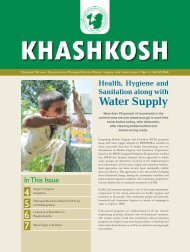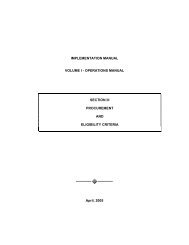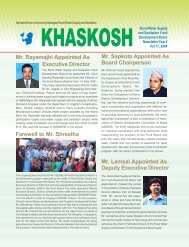ANNUAL REPORT_2008.pdf - Rural Water Supply and Sanitation ...
ANNUAL REPORT_2008.pdf - Rural Water Supply and Sanitation ...
ANNUAL REPORT_2008.pdf - Rural Water Supply and Sanitation ...
Create successful ePaper yourself
Turn your PDF publications into a flip-book with our unique Google optimized e-Paper software.
Micro-Irrigation<br />
The Board has endeavored to introduce the microirrigation<br />
component as an integral part of the program<br />
piloting from Batch - VI onwards utilizing the available<br />
excess water from the water supply system for<br />
vegetable/cash crop farming. So far the technical manual<br />
for drip irrigation has been prepared. Due to some<br />
limitation, the micro irrigation schemes have not yet<br />
been initiated. However, the communities are using the<br />
waste water <strong>and</strong> excess water from the taps for kitchen<br />
gardening.<br />
Rain <strong>Water</strong><br />
Harvesting (RWH)<br />
Specially, in the hilly areas where there are no alternate<br />
sources suitable for gravity schemes, the RWH schemes<br />
are designed for implementation. The Board has<br />
developed the technical guidelines for design, estimation<br />
<strong>and</strong> construction of the RWH. In 2007, four RWH schemes<br />
were implemented in western hill districts of Nepal.<br />
Small Pump (Lift) Scheme<br />
These schemes are proposed in Terai<br />
communities where the shallow tube well<br />
<strong>and</strong> dug wells are not suitable for drinking<br />
purposes due to arsenic <strong>and</strong> the high iron<br />
content problem. The water quality test<br />
report also showed that the shallow tube<br />
wells <strong>and</strong> dug wells remain at high risk of<br />
faecal contamination. There has been<br />
increasingly a dem<strong>and</strong> for such schemes<br />
in Batch VI <strong>and</strong> onwards. It will be quite<br />
appropriate to promote such type of<br />
schemes in the Terai area if the<br />
communities are willing to pay <strong>and</strong> can<br />
afford future O & M costs <strong>and</strong> if electricity<br />
is available.<br />
These schemes have a small bore hole near<br />
the reservoir <strong>and</strong> an electrical submersible<br />
pump to lift the water to the elevated<br />
reservoir (RCC/ferro-cement) to supply<br />
water under gravity. In some cases, where<br />
the elevated natural ground profile is<br />
available, ferro-cement reservoirs are<br />
constructed. Based on the knowledge from<br />
Batch - V schemes, a cost effective design<br />
will be prepared <strong>and</strong> implemented in the<br />
forthcoming batches.<br />
14 · RWSSFDB Annual Report 2008



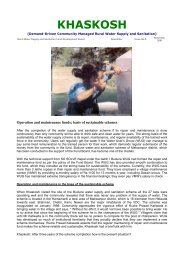
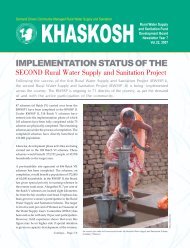
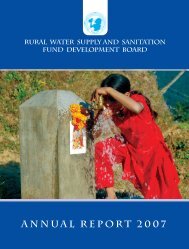
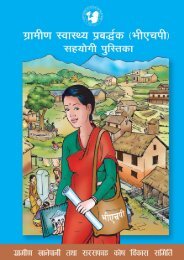


![vfg]k fgL tyf ;/;kmfOsf] If]qdf sf]if ljsf; ;ldltsf] cjwf/0ff pTs[i7 cEof](https://img.yumpu.com/38832733/1/190x245/vfgk-fgl-tyf-kmfosf-ifqdf-sfif-ljsf-ldltsf-cjwf-0ff-ptsi7-ceof.jpg?quality=85)

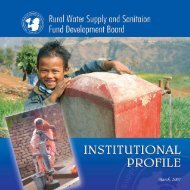
![Request for Proposals RFP # [162] - Rural Water Supply and ...](https://img.yumpu.com/38832347/1/184x260/request-for-proposals-rfp-162-rural-water-supply-and-.jpg?quality=85)
